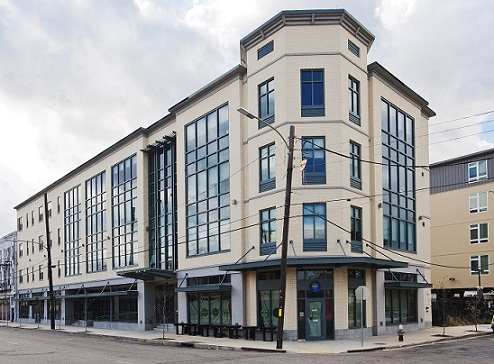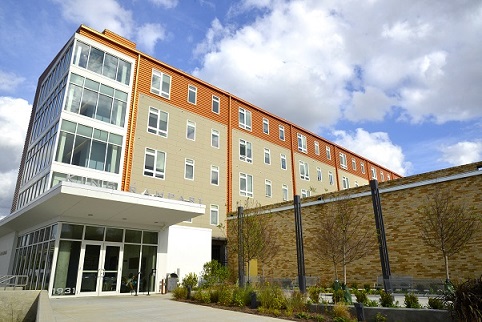
New Mixed-Use Development in New Orleans’ Central City Neighborhood

The 20,000-square-foot commercial wing of the Harrell Building fronts on O.C. Haley Boulevard, an important commercial and cultural corridor in the Central City neighborhood of New Orleans. Image courtesy of Bruce Keyes.
New Orleans’ Central City was once a working-class neighborhood, complete with a vibrant arts scene and cultural institutions, as well as a history of civil rights activism. During the late twentieth century, however, the neighborhood experienced disinvestment, blight, poverty, and crime that were exacerbated by Hurricane Katrina in 2005 and the recent economic recession. From 2008 to 2012, according to The Data Center, 42 percent of the residents of the predominantly African American neighborhood lived in poverty, and 60.5 percent of renters spent 30 percent or more of their income on housing. A recent redevelopment effort in Central City that helps address this need for affordable housing is the Harrell Building, which consists of two parts: a 20,000-square-foot commercial wing facing Oretha Castle Haley (O.C. Haley) Boulevard, an important commercial and cultural corridor in Central City, and a 64,000 square-foot residential wing known as King Rampart Apartments on Martin Luther King Jr. Boulevard. Completed in summer 2012, the mixed-use building was designed by CCWIV Architecture and developed by the Gulf Coast Housing Partnership (GCHP), a nonprofit development company, in partnership with the New Orleans Redevelopment Authority (NORA).
Mixed Uses in the Harrell Building
The anchor tenant of the Harrell Building’s four-story commercial wing is NORA, which leases the upper three floors. With some space still available for lease, current tenants of the ground floor space include a coffee shop and CeaseFire New Orleans, a nonprofit organization committed to reducing violence in targeted areas of the city.
King Rampart Apartments, a mixed-income development, contains 70 apartments for seniors aged 55 and older; 49 of the units are affordable to households earning no more than 60 percent of the area median income and the rest are market-rate units. The Housing Authority of New Orleans has provided 17 project-based vouchers. These include four vouchers from the state of Louisiana’s Permanent Supportive Housing program for individuals and families affected by Hurricanes Katrina and Rita who earn extremely low incomes or have disabilities and who need supportive services for independent living.

King Rampart Apartments, the 64,000-square-foot residential wing of the Harrell Building, contains 70 apartments for seniors aged 55 and older of which 49 units are affordable at 60 percent of the area median income. Image courtesy of Harry Connelly.
The five-story building contains 30 one-bedroom and 40 two-bedroom apartments, with administrative offices and a multipurpose meeting room on the ground floor. The building has been designed to meet Enterprise Green Communities criteria. Apartment amenities include ENERGY STAR®-qualified appliances and lighting; paints, adhesives, and sealants with low or no volatile organic compounds; and internet and cable access. Other amenities include furnished lounges on each floor and a secure outdoor landscaped area.
Harrell Building Financing
The total development cost for the Harrell Building was $20.6 million. Funding sources for the $14.7 million King Rampart Apartments included $3.2 million from low-income housing tax credits syndicated by Enterprise Community Investment, $1.7 million from phase 1 of the Neighborhood Stabilization Program and another $1.7 million from phase 2, and $8.1 million from the city’s community development block grant program. Funding sources for the $5.9 million commercial wing include New Markets Tax Credit (NMTC) program funds, Gulf Opportunity Zone Bonds, and private loans. The community development entity contributing NMTC funds to the project is the Local Initiatives Support Corporation.
Regenerating the Central City Neighborhood
Designated a target area by NORA, Central City has been the focus of considerable attention by government agencies, nonprofit organizations, and the private sector. By 2010, the neighborhood had regained nearly 70 percent of its pre-Katrina population, an increase of more than 15 percent from March 2008, and King Rampart Apartments will help serve the housing needs of this growing population. In addition to the Harrell Building’s offices and retail space, new commercial and cultural venues have appeared on O.C. Haley Boulevard, including the New Orleans Jazz Orchestra’s Jazz Market building and the New Orleans Food and Beverage Museum. As the efforts of NORA, GCHP, and other organizations continue in Central City, the Harrell Building adds its own impetus to redevelopment efforts in the neighborhood while also providing affordable housing and business opportunities.
PD&R Leadership Message Archive
International & Philanthropic Spotlight Archive
Spotlight on PD&R Data Archive
Publications
Collecting, Analyzing, and Publicizing Data on Housing Turnover
Resilience Planning: What Communities Can Do to Keep Hazards from Turning into Disasters
Cityscape: Volume 26, Number 3
Case Studies
Case Study: Former School in Charleston, South Carolina, Transformed into Affordable Housing for Seniors
Case Study: Avalon Villas Combines Affordable Housing and Services for Families in a Gentrifying Phoenix Neighborhood

The contents of this article are the views of the author(s) and do not necessarily reflect the views or policies of the U.S. Department of Housing and Urban Development or the U.S. Government.
Note: Guidance documents, except when based on statutory or regulatory authority or law, do not have the force and effect of law and are not meant to bind the public in any way. Guidance documents are intended only to provide clarity to the public regarding existing requirements under the law or agency policies.



